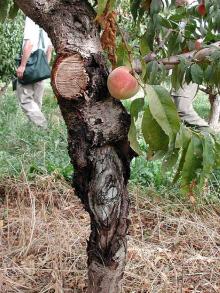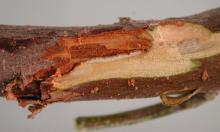Cause The specific pathogen(s) in the PNW has not been formally identified but the fungi Cytospora cincta (sexual: Leucostoma cinctum), and the closely related C. leucostoma (sexual: Leucostoma persoonii) have been suggested. Molecular techniques have identified C. pulriova from peach cankers in CA and CO and SC. These are vigorous wound invaders (including wounds from sunscald and winter injury) that ramify throughout the bark and cambium and to a lesser extent the tree's structural wood. The firm, red peach cultivars such as Zee Lady and Sierra Rich are particularly susceptible.
Overwintering is in infected stems and stem debris on the ground. These fungi have a wide host range and can infect virtually all stone fruit and pome fruit trees. They can be devastating in cherry, peach, and apricot orchards. Conidia are produced in cherry and peach orchards in eastern Washington throughout the year and the inoculum concentration is highest during the spring and summer. Over-the-canopy and under-tree sprinkler irrigation can promote sporulation and disperse conidia. Cankers have been reported on apple in all Pacific Northwest regions, especially after severe winters. Various ornamental shrubs and trees are susceptible as well. All these hosts can provide overwintering sites. Cytospora fungi do not destroy the tree's structural strength, but other fungi (principally the genera Stereum and Polyporus) commonly invade the Cytospora infection sites and cause rapid wood rotting, which adds to the severity of the disease's effects.
Symptoms To the casual observer, the first evidence of infection usually is dead twigs. Leaves above stem infections droop and discolor through shades of green to various shades of brown; they remain attached, sometimes through the winter. These "flags" are caused by stem invasions that have raised cankers that girdle or nearly girdle the stem immediately below the flag. Canker surfaces develop raised pinhead-size pimples (pycnidia) in the bark of most smooth-bark cultivars, but these may not be readily visible in cankers on peach and cherry stems. Amber to orange, hair-like spore tendrils extrude from the pycnidia in humid weather. These break off easily and can be blown about, tracked around by insects, and splashed by rain. In very wet weather, an amber spore droplet instead of the spore hair may form on the pycnidia.
Cankers are small at first but slowly enlarge elliptically; sometimes they streak rapidly up and down the stem without immediate girdling. In late season, a callus forms at canker margins, and fungal activity resumes in spring. If branches and trees do not die outright, they look very ragged; this stage is often known as perennial canker. All cultivars are susceptible, but reaction to invasion varies widely. Weakened trees are always easy victims. In Idaho, this disease is the limiting factor in 'President' plum production.
Cultural control
- Remove dead branches, cutting well below (at least 1 ft) any visible discoloration in the bark.
- Do not establish new orchards close to or downwind from badly diseased orchards.
- Treetop or other hedgerow pruning and overhead irrigation are not advised where the disease is a problem.
- Take special care to avoid wounding trees during the growing season. Tractors and sprayers commonly inflict such wounds, as do shakers, ladders, and pickers' feet.
- Control all insect and disease problems, such as brown rot of stone fruits, even in the first few nonbearing years.
- Train trees properly.
- Avoid rodent injury.
- Avoid excessive nitrogen fertilization, nitrogen applications late in the growing season, or late-season cultivation or irrigation.
- Paint the southwest side of tree trunks with white latex paint to avoid winter injury.
- Prune as late as possible in the dormant season. Prune in dry weather.
- Summer pruning can be helpful as long as wounds can be kept dry for 2 to 3 weeks.
- Surgically remove cankers from trunks and scaffold limbs in summer.
Chemical control The use of latex paint, Captan and/or Topsin was shown to be effective wound protectants prior to infection in Colorado. Latex paint, however, did not result in long term effective control. Lime sulfur gave variable results. Use of these materials after pruning or winter injury may be helpful. Use of copper-based fungicides was not only ineffective but resulted in some cases to be phytotoxic.
- Topsin 4.5 FL at 30 fl oz/A as a spray directed onto cuts within 24 hr of pruning. A second spray 2 weeks later is recommended. Topsin 4.5 FL may also be used at 4 fl oz/1 gal water and applied as a paint to cut or pruned surfaces. Use when rain is not expected after application. Group 1 fungicide. 2-day reentry.
References Grove, G.G., and Biggs, A.R. 2006. Production and dispersal of conidia of Leucostroma cinctum in peach and cherry orchards under irrigation in Eastern Washington. Plant Disease 90:587-591.
Miller, S.T., Otto, K.L., Sterle, D., Minas, I.S., and Stewart, J.E. 2019. Preventive Fungicidal Control of Cytospora leucostoma in Peach Orchards in Colorado. Plant Disease 103:1138-1147.





